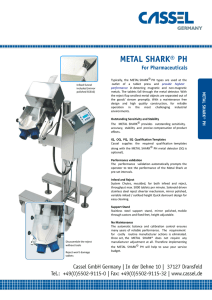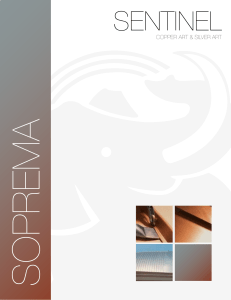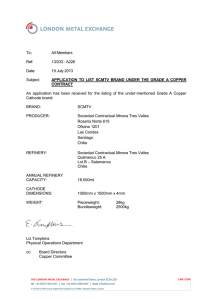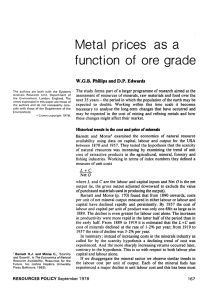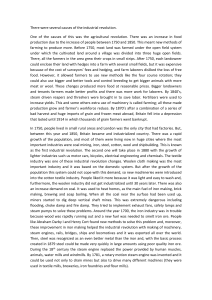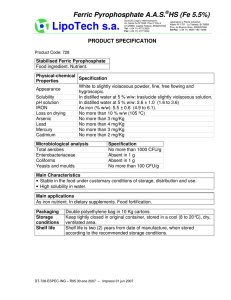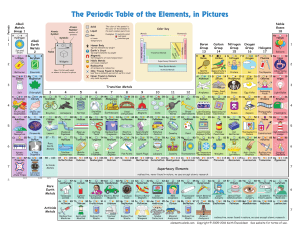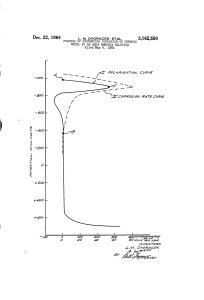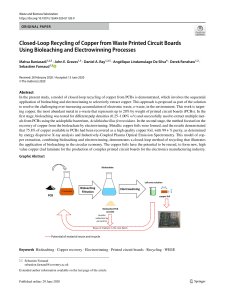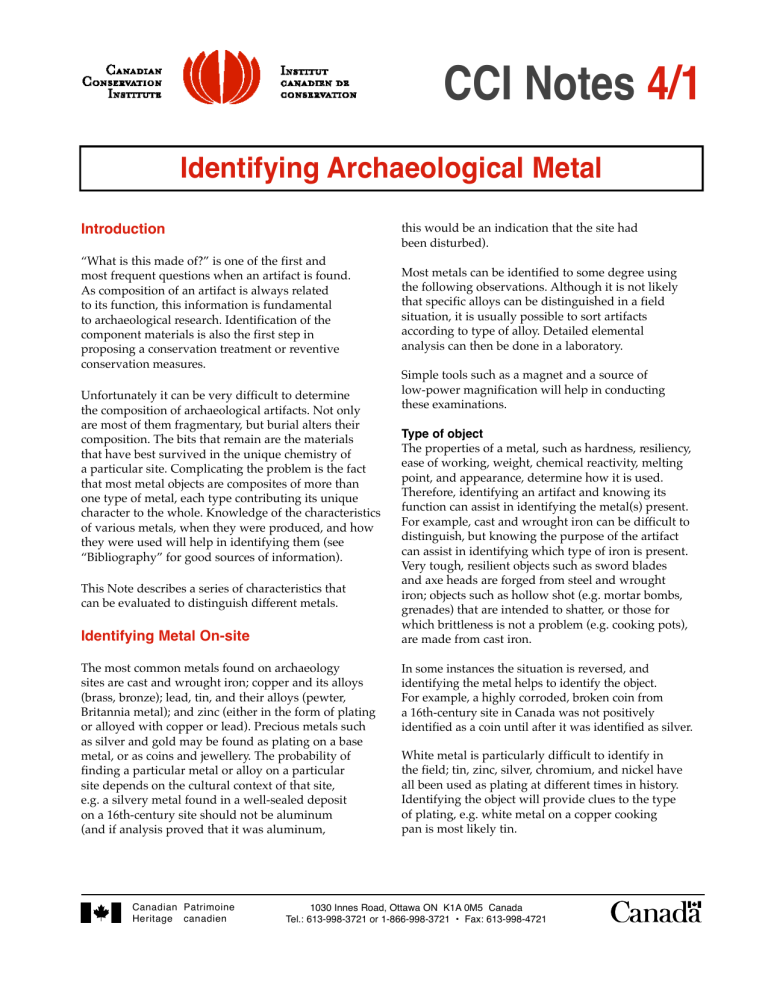
CCI Notes 4/1 Identifying Archaeological Metal this would be an indication that the site had been disturbed). Introduction “What is this made of?” is one of the first and most frequent questions when an artifact is found. As composition of an artifact is always related to its function, this information is fundamental to archaeological research. Identification of the component materials is also the first step in proposing a conservation treatment or reventive conservation measures. Unfortunately it can be very difficult to determine the composition of archaeological artifacts. Not only are most of them fragmentary, but burial alters their composition. The bits that remain are the materials that have best survived in the unique chemistry of a particular site. Complicating the problem is the fact that most metal objects are composites of more than one type of metal, each type contributing its unique character to the whole. Knowledge of the characteristics of various metals, when they were produced, and how they were used will help in identifying them (see “Bibliography” for good sources of information). This Note describes a series of characteristics that can be evaluated to distinguish different metals. Identifying Metal On-site The most common metals found on archaeology sites are cast and wrought iron; copper and its alloys (brass, bronze); lead, tin, and their alloys (pewter, Britannia metal); and zinc (either in the form of plating or alloyed with copper or lead). Precious metals such as silver and gold may be found as plating on a base metal, or as coins and jewellery. The probability of finding a particular metal or alloy on a particular site depends on the cultural context of that site, e.g. a silvery metal found in a well-sealed deposit on a 16th-century site should not be aluminum (and if analysis proved that it was aluminum, Canadian P a t r i m o i n e Heritage canadien Most metals can be identified to some degree using the following observations. Although it is not likely that specific alloys can be distinguished in a field situation, it is usually possible to sort artifacts according to type of alloy. Detailed elemental analysis can then be done in a laboratory. Simple tools such as a magnet and a source of low-power magnification will help in conducting these examinations. Type of object The properties of a metal, such as hardness, resiliency, ease of working, weight, chemical reactivity, melting point, and appearance, determine how it is used. Therefore, identifying an artifact and knowing its function can assist in identifying the metal(s) present. For example, cast and wrought iron can be difficult to distinguish, but knowing the purpose of the artifact can assist in identifying which type of iron is present. Very tough, resilient objects such as sword blades and axe heads are forged from steel and wrought iron; objects such as hollow shot (e.g. mortar bombs, grenades) that are intended to shatter, or those for which brittleness is not a problem (e.g. cooking pots), are made from cast iron. In some instances the situation is reversed, and identifying the metal helps to identify the object. For example, a highly corroded, broken coin from a 16th-century site in Canada was not positively identified as a coin until after it was identified as silver. White metal is particularly difficult to identify in the field; tin, zinc, silver, chromium, and nickel have all been used as plating at different times in history. Identifying the object will provide clues to the type of plating, e.g. white metal on a copper cooking pan is most likely tin. 1030 Innes Road, Ottawa ON K1A 0M5 Canada Tel.: 613-998-3721 or 1-866-998-3721 • Fax: 613-998-4721 Corrosion Nearly all metals corrode during burial. Corrosion products can form as thin, coherent layers or thick, disfiguring crusts which obscure the details of the object. They may protect the underlying metal or they may contain salts that will cause further corrosion after the object has been excavated (for more information on corrosion, see CCI Notes 9/1 Recognizing Active Corrosion). These corrosion products are distinctly coloured, some intensely so. The corrosion products are the first visual clue to the composition of the underlying metal, and reflect both the type of metal and the chemistry of the soil. Corrosion on iron usually takes the form of rust, a generic term to describe the iron oxyhydroxides or minerals that form when metallic iron reacts with oxygen and water vapour, creating a crust that can be shades of brown, reddish-brown, yellow, or orange. In soil with a high phosphate content, vivianite (blue iron phosphate) can form on iron. A burned iron object may have a layer of deep red haematite (iron oxide) directly over the metal. Magnetite (also iron oxide) may be present as a thin, coherent dark layer directly on iron. Magnetite on iron looks very much like the dark patina that forms on copper. However, because lightly corroded iron is magnetic and copper is not, the two can be easily distinguished with a magnet. Corrosion on copper is usually composed of a crust that varies in shades of blue and green (copper carbonates, azurite, and malachite) overlying a powdery red or compact dark layer. Spots of softer, pale green corrosion might also be visible in the layers. Copper and copper alloys may be lightly corroded with a thin, dark patina. Brass (an alloy of copper and zinc) might have white whiskers of zinc corrosion, although this is rarely seen on archaeological brass because the zinc corrosion dissolves in burial, leaving a surface rich in copper. High-lead bronzes might have spots of white lead carbonate where the lead has separated out as small blobs. Corrosion products on lead, usually white lead carbonate, form an adherent, soft layer relatively evenly over the metal surface. It is possible to find red lead oxide on archaeological objects, but this is rare. Pewter (a tin/lead alloy with a high tin content) and Britannia metal (another alloy with a high tin content [tin/antimony/copper] that closely resembles pewter) develop either warts of corrosion or disfiguring thick, cracked, and crusty layers. Contact with the soil discolours the outer corrosion layer of both pure lead and tin alloys. Silver might appear silvery when first excavated. On exposure to light, however, the surface will turn 2 purplish-grey due to the presence of light-sensitive silver chloride, a common corrosion product on archaeological silver. Both silver and gold are often alloyed with copper which forms green or reddish corrosion, indicating debased precious metal. Colour of the metal The colour of metal is an indication of its composition, but it is unreliable on its own. Therefore the colour of metal should be examined only if there are exposed surfaces; do not scratch through corrosion as this can leave the object permanently marked. Iron stripped of corrosion looks silvery or grey. If the soil contains dissolved copper, metallic copper may plate out on iron during burial. Pure copper has a reddish tinge and brass is quite yellow. Pure gold is also yellow, but it has a different lustre than brass. Bronze varies in tone from a warmer gold than brass to golden brown, depending on the tin and lead content. Alloys cannot be distinguished by colour alone. Various shades of yellow, red, white, and silver characterize gold, silver, and copper alloys, leading to the descriptive terms red gold (a gold/copper alloy) and white gold (gold with a high silver content). Nickel-silver, known by many names, is an alloy of copper, zinc, and nickel that does not contain silver but looks silvery. Crystal structure All metals are crystalline and corrosion progresses preferentially along the crystal (also called grain) boundaries. The shape of the crystals is specific to the composition and method of manufacture of the particular metal. To examine the crystal structure, look at any broken edges and exposed surfaces of artifacts. Metals chemically stripped of corrosion often look etched. Identifiable structures include dendrites in cast copper alloys, which form as the metal cools in a mould, separating into copper-rich and zinc- or tin-rich phases. Wrought iron corrodes along the grains of silica inclusions in the metal, resulting in a stringy look. Cast iron has a brittle fracture, and needle-like crystals perpendicular to the surface of the object might be visible. Magnetic attraction Objects made of iron (or those that contain iron) exhibit an attraction to a magnet passed over the surface, the strength of which indicates the amount and location of iron. Even a completely corroded iron object attracts a magnet weakly. Nickel is another metal with magnetic properties. It is resistant to corrosion and is most often used in platings and corrosion-resistant alloys (where there may not be enough of it to be detected magnetically). Nickel-silver is not magnetic. CCI Notes 4/1 Plating Plating (applying one metal on another) was done by various methods and for various reasons, e.g. tinned copper cooking pans and tin cans (tinned iron) were plated for utilitarian purposes whereas plating on buttons, medals, and jewellery was for decoration. The most common types of plating prior to the 19th century were tin, silver, and gold, and the base metals included copper and copper alloys and iron, the corrosion products of which often obscure the plating. Early forms of plating were applied by dipping a base metal into molten plating metal or by fusing sheets of the plating metal over the base. Electroplating, a technique developed in the 19th century, gives a thinner, more uniform coating than the earlier methods. Galvanizing refers to zinc plating over iron, which became common in the 19th century. A spangled coating indicates that the iron was galvanized by dipping sheet iron into molten zinc. Electroplated zinc coating lacks the conspicuous spangles of hot-dipped zinc. Weight, density, and relative hardness Metals that are similar in appearance can sometimes be distinguished by differences in weight, density, and relative hardness. Evaluation of these factors should not involve scratching the surface or other invasive testing. Aluminum and lead are both silvery-grey but aluminum is very lightweight in comparison to lead. High-lead bronzes are heavier than brass or copper. Highly corroded wrought iron is lighter in weight than solid metal and the shape of the object might be distorted by corrosion; in contrast, heavily corroded grey cast iron is very light and soft (due to carbon in the form of flakes of graphite, which don’t corrode) and retains the original dimensions of the object. Method of fabrication Traces of manufacture or wear provide a wealth of information about the history of an object. Flash lines from a mould might be visible on cast metal, or the crystal structure may be consistent with metal that separated into phases when it cooled from a melt. Hammering and other methods of surface finishing such as turning on a lathe may have left tool marks (learning to recognize tool marks is very useful when studying metals). The pattern of corrosion can also indicate the method of manufacture because metals that were mechanically worked and not annealed properly to relieve stress in the crystal structure will have corroded in areas of stress. Iron and copper objects were often reworked using mechanical methods. Evidence of this type of recycling can be found on North American sites where Aboriginal people had access to imported European objects. CCI Notes 4/1 Makers’ marks These indicate exactly the type of metal, and can be identified accurately by consulting catalogues of makers’ marks. Gold, silver, silver plate, and pewter are usually marked. Laboratory Tests Elemental analysis in the laboratory can be used to augment initial on-site identification. It can answer the question “what elements are present”, but cannot give definitive information about metallic structure. If detailed analysis of the methods used to manufacture an object is necessary, a metallurgist should be consulted. Chemical spot tests and touchstone tests Spot tests require a clean metal surface, specialized chemicals, and a set of reference metals of known composition. A tiny portion of the metal to be identified is first dissolved, either chemically or electrolytically, and then the dissolved metal is reacted with a chemical reagent to produce a colour that is specific to that metal (this is analogous to inducing the formation of corrosion products, which are coloured compounds). The metal can then be identified by checking the results against a reference standard. Unfortunately corroded archaeological metals are often composed of more than one metal, and this may skew the results. Likewise dissolved salts from the burial environment are sometimes present on the surface of the metal and these may react with the spot test reagent, which also interferes with the results. Touchstone tests, or streak tests, are done by rubbing the metal on a touchstone, which has a hard, white, matte surface. The colour of the streak left on the surface is specific to the metals present. The imprecision of this technique limits its value. Instrumental analysis The best method of visually recording a collection of metals is radiography, which provides a wealth of information including the true shape of the object and the extent and location of corrosion. Different metals appear as different densities on a radiograph. Plating (either gold, silver, or tin) appears as a bright line on the surface; corrosion products that are more dense than the underlying metal (such as compact magnetite on corroded iron) also look like a discrete layer. Stress corrosion cracking is visible, as are welded joins and solder lines. It may be possible to read corroded coins from a radiograph, and makers’ marks, if present, will be evident. For more precise identification of metal, X-Ray Energy Spectrometry (XES, also described in texts as Energy Dispersive X-Ray Spectrometry, or EDX) is commonly 3 used. This is a non-destructive technique wherein a small area on the surface of an object is bombarded with X-rays, causing the metal atoms to emit secondary X-rays (energy) that are characteristic of the elements present. XES analyses only the surface, which in the case of alloys is often not the true composition of the underlying metal. (Surfaces of alloys are depleted of metals that are more prone to corrosion, such as zinc depletion on a brass object. Objects can also pick up other metals during burial, which will skew this analysis.) If plating is present, XES will not discriminate between the plating and the underlying metal. XES gives an idea of the relative amounts of metal present, but precise compositional information cannot be obtained for objects that have irregular shapes or for which the surface is not representative of the entire object. In spite of these drawbacks, XES adequately answers most of the questions pertinent to archaeological objects, such as whether an artifact is bronze or brass, pewter or Britannia metal. If more information is required, a small hole can be drilled into the body of the metal to expose uncorroded material, or a small fragment can be removed to prepare a polished section for metallography (analysis of the crystal structure) and X-ray microanalysis. Bibliography Neutron activation analysis (NAA) can be used to detect trace elements and obtain precise quantitative data. A small sample is removed from an uncorroded section of metal and irradiated in a nuclear reactor. The reactor produces neutrons that react with the nuclei of elements in the sample, causing them to emit gamma rays. Measurement of the intensity of the gamma rays provides a fingerprint of both the type and quantity of elements present. NAA has been used to examine collections of copper and copper alloy artifacts from North American sites. The technique is precise enough to differentiate between artifacts made from metallic copper from naturally occurring sources (native copper) and copper smelted from an ore. Rogers, B.A. The Nature of Metals. Cambridge, MA: The M.I.T. Press, 1964. Child, R.E., and J.M. Townsend, eds. Modern Metals in Museums. London, UK: Institute of Archaeology Publications, 1988. Corbeil, M.-C. “X-ray Spectrometry at CCI.” CCI Newsletter No. 17 (March 1996), pp. 5–6. Hancock, R.G.V, et al. “Distinguishing European Trade Copper and North-eastern North American Native Copper.” Archaeometry 33, 1 (1991), pp. 69–86. Hodges, H. Artifacts. New York, NY: Praeger, 1984. Light, J.D. “A Field Guide to the Identification of Metal.” pp. 3–19 in Studies in Material Culture Research (edited by K. Karklins). California, PA: Society for Historical Archaeology, 2000. Light, J.D., and H. Unglik. A Frontier Fur Trade Blacksmith Shop 1796~1812. Studies in Archaeology Architecture and History. Ottawa, ON: National Historic Parks and Sites Branch, Parks Canada, Environment Canada, 1984. Tite, M.S. Methods of Physical Examination in Archaeology. London, UK: Seminar Press, 1972. Watkinson, D., ed. First Aid for Finds. London, UK: The British Archaeology Trust, 1987. Conclusion by Judy Logan When working on a site or planning the care of a collection of archaeological objects, knowing which types of metals are present (i.e. iron, copper or copper alloys, white metal, lead or tin alloys) is often adequate. A metal should never be identified as a specific alloy or composition if there is any doubt. Misinformation is much more misleading than an imprecise, yet accurate, general identification. Originally published 2002 Revised 2007 The identification of archaeological metals contributes to the proper treatment and care of metal artifacts, which in turn ensures that they will remain a valid resource for future research. 4 Copies are also available in French. Texte également publié en version française. ©Minister of Public Works and Government Services Canada, 2007 Cat. No. NM95-57/4-1-2007E ISSN 0714-6221 Printed in Canada CCI Notes 4/1
